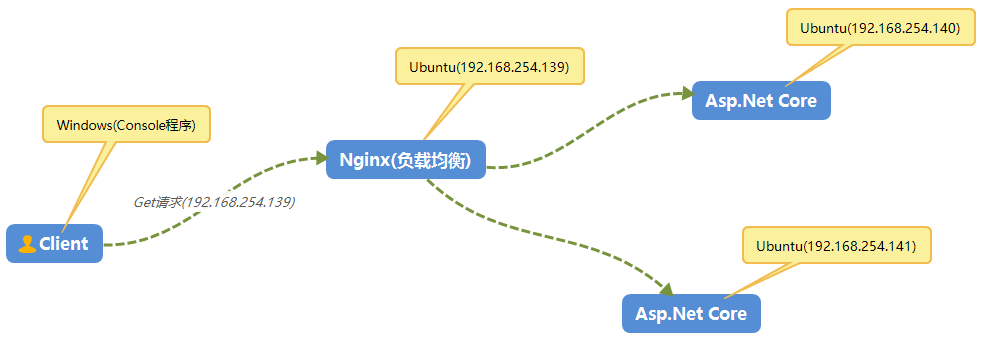一.实现前的准备
- 以下是实现简单负载均衡的思路,图中的服务器均为虚拟机

- 三台Linux服务器,一台用作Nginx负载均衡(192.168.254.139),另外两台用作Asp.Net Core应用程序承载的服务器(192.168.254.140,192.168.254.141)
- 一台用作于Client的Windows服务器。
二.环境搭建
1.Asp.Net Core程序
就是一个新建的空web应用程序,然后修改了下Startup的中间件,分别部署到2台Ubuntu上。
public class Startup { // This method gets called by the runtime. Use this method to add services to the container. // For more information on how to configure your application, visit https://go.microsoft.com/fwlink/?LinkID=398940 public void ConfigureServices(IServiceCollection services) { } // This method gets called by the runtime. Use this method to configure the HTTP request pipeline. public void Configure(IApplicationBuilder app, IHostingEnvironment env) { if (env.IsDevelopment()) { app.UseDeveloperExceptionPage(); } app.Run(async (context) => { //await context.Response.WriteAsync("this is first web application"); await context.Response.WriteAsync("this is second web application"); }); } }
2.配置Nginx服务器
- 安装Nginx
- 在Ubuntu终端使用 sudo apt-get install nginx 命令安装Nginx。
- 然后通过 sudo service nginx start 命令启动服务
- 确认浏览器显示Nginx默认登录页。可在http://192.168.254.139/index.nginx-debian.html 访问登录页面。
- 配置Nginx
- 若要将 Nginx 配置为反向代理以将请求转接到 ASP.NET Core 应用,请修改 /etc/nginx/sites-available/default。 sudo vi /etc/nginx/sites-available/default
- 设置proxy_pass后面的参数
- 新增upstream,表示要转接的服务器集合,upstream后面的名字要与proxy_pass后面的参数相对应
- 修改完之后:wq保存,然后 sudo nginx -t 来验证配置文件的语法有没有错误,如果配置文件测试成功,可以通过运行 sudo nginx -s reload 强制 Nginx 选取更改
upstream cluster.com{ server 192.168.254.140 weight=1; server 192.168.254.141 weight=1; } server { listen 80 default_server; # listen [::]:80 default_server deferred; # SSL configuration # # listen 443 ssl default_server; # listen [::]:443 ssl default_server; # # Note: You should disable gzip for SSL traffic. # See: https://bugs.debian.org/773332 # # Read up on ssl_ciphers to ensure a secure configuration. # See: https://bugs.debian.org/765782 # # Self signed certs generated by the ssl-cert package # Don't use them in a production server! # # include snippets/snakeoil.conf; root /var/www/html; # Add index.php to the list if you are using PHP index index.html index.htm index.nginx-debian.html; server_name _example.com *.example.com; location / { proxy_pass http://cluster.com; proxy_http_version 1.1; proxy_set_header Upgrade $http_upgrade; proxy_set_header Connection keep-alive; proxy_set_header Host $host; proxy_cache_bypass $http_upgrade; proxy_set_header X-Forwarded-For $proxy_add_x_forwarded_for; proxy_set_header X-Forwarded-Proto $scheme; # First attempt to serve request as file, then # as directory, then fall back to displaying a 404. try_files $uri $uri/ =404; } # pass PHP scripts to FastCGI server # #location ~ .php$ { # include snippets/fastcgi-php.conf; # # # With php-fpm (or other unix sockets): # fastcgi_pass unix:/var/run/php/php7.0-fpm.sock; # # With php-cgi (or other tcp sockets): # fastcgi_pass 127.0.0.1:9000; #} # deny access to .htaccess files, if Apache's document root # concurs with nginx's one # #location ~ /.ht { # deny all; #} }
2.Client控制台应用程序
class Program { static void Main(string[] args) { HttpClient httpClient = new HttpClient(); for (int i = 0; i < 1000; i++) { string result = httpClient.GetStringAsync("http://192.168.254.139").Result; Console.WriteLine(result); } Console.ReadKey(); } }
结果如下:

由结果可知,Nginx服务器会根据我们配置Nginx时的权重进行转向,到现在,一个简单的集群已经搭建。